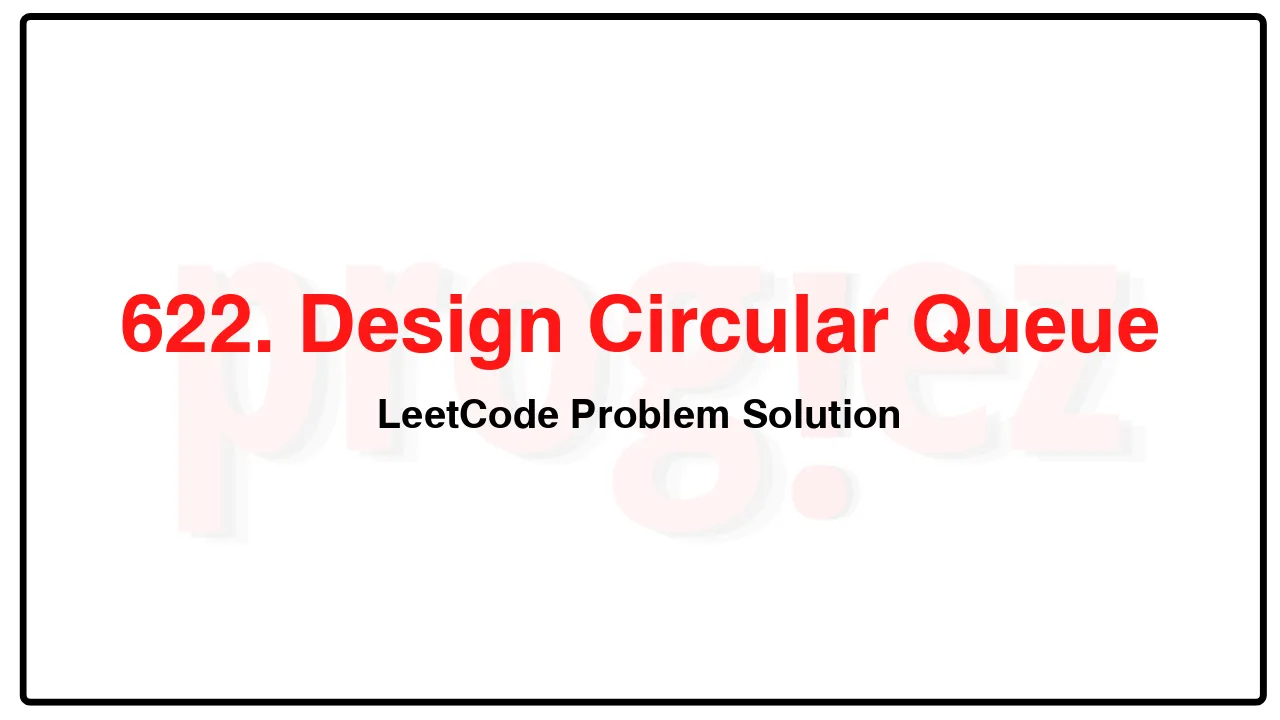622. Design Circular Queue LeetCode Solution
In this guide, you will get 622. Design Circular Queue LeetCode Solution with the best time and space complexity. The solution to Design Circular Queue problem is provided in various programming languages like C++, Java, and Python. This will be helpful for you if you are preparing for placements, hackathons, interviews, or practice purposes. The solutions provided here are very easy to follow and include detailed explanations.
Table of Contents
- Problem Statement
- Complexity Analysis
- Design Circular Queue solution in C++
- Design Circular Queue solution in Java
- Design Circular Queue solution in Python
- Additional Resources

Problem Statement of Design Circular Queue
Design your implementation of the circular queue. The circular queue is a linear data structure in which the operations are performed based on FIFO (First In First Out) principle, and the last position is connected back to the first position to make a circle. It is also called “Ring Buffer”.
One of the benefits of the circular queue is that we can make use of the spaces in front of the queue. In a normal queue, once the queue becomes full, we cannot insert the next element even if there is a space in front of the queue. But using the circular queue, we can use the space to store new values.
Implement the MyCircularQueue class:
MyCircularQueue(k) Initializes the object with the size of the queue to be k.
int Front() Gets the front item from the queue. If the queue is empty, return -1.
int Rear() Gets the last item from the queue. If the queue is empty, return -1.
boolean enQueue(int value) Inserts an element into the circular queue. Return true if the operation is successful.
boolean deQueue() Deletes an element from the circular queue. Return true if the operation is successful.
boolean isEmpty() Checks whether the circular queue is empty or not.
boolean isFull() Checks whether the circular queue is full or not.
You must solve the problem without using the built-in queue data structure in your programming language.
Example 1:
Input
[“MyCircularQueue”, “enQueue”, “enQueue”, “enQueue”, “enQueue”, “Rear”, “isFull”, “deQueue”, “enQueue”, “Rear”]
[[3], [1], [2], [3], [4], [], [], [], [4], []]
Output
[null, true, true, true, false, 3, true, true, true, 4]
Explanation
MyCircularQueue myCircularQueue = new MyCircularQueue(3);
myCircularQueue.enQueue(1); // return True
myCircularQueue.enQueue(2); // return True
myCircularQueue.enQueue(3); // return True
myCircularQueue.enQueue(4); // return False
myCircularQueue.Rear(); // return 3
myCircularQueue.isFull(); // return True
myCircularQueue.deQueue(); // return True
myCircularQueue.enQueue(4); // return True
myCircularQueue.Rear(); // return 4
Constraints:
1 <= k <= 1000
0 <= value <= 1000
At most 3000 calls will be made to enQueue, deQueue, Front, Rear, isEmpty, and isFull.
Complexity Analysis
- Time Complexity: O(1)
- Space Complexity: O(k)
622. Design Circular Queue LeetCode Solution in C++
class MyCircularQueue {
public:
/** Initialize your data structure here. Set the size of the queue to be k. */
MyCircularQueue(int k) : k(k), q(k), rear(k - 1) {}
/** Insert an element into the circular queue. Return true if the operation is
* successful. */
bool enQueue(int value) {
if (isFull())
return false;
rear = ++rear % k;
q[rear] = value;
++size;
return true;
}
/** Delete an element from the circular queue. Return true if the operation is
* successful. */
bool deQueue() {
if (isEmpty())
return false;
front = ++front % k;
--size;
return true;
}
/** Get the front item from the queue. */
int Front() {
return isEmpty() ? -1 : q[front];
}
/** Get the last item from the queue. */
int Rear() {
return isEmpty() ? -1 : q[rear];
}
/** Checks whether the circular queue is empty or not. */
bool isEmpty() {
return size == 0;
}
/** Checks whether the circular queue is full or not. */
bool isFull() {
return size == k;
}
private:
const int k;
vector<int> q;
int size = 0;
int front = 0;
int rear;
};
/* code provided by PROGIEZ */622. Design Circular Queue LeetCode Solution in Java
class MyCircularQueue {
/** Initialize your data structure here. Set the size of the queue to be k. */
public MyCircularQueue(int k) {
this.k = k;
this.q = new int[k];
this.rear = k - 1;
}
/** Insert an element into the circular queue. Return true if the operation is successful. */
public boolean enQueue(int value) {
if (isFull())
return false;
rear = ++rear % k;
q[rear] = value;
++size;
return true;
}
/** Delete an element from the circular queue. Return true if the operation is successful. */
public boolean deQueue() {
if (isEmpty())
return false;
front = ++front % k;
--size;
return true;
}
/** Get the front item from the queue. */
public int Front() {
return isEmpty() ? -1 : q[front];
}
/** Get the last item from the queue. */
public int Rear() {
return isEmpty() ? -1 : q[rear];
}
/** Checks whether the circular queue is empty or not. */
public boolean isEmpty() {
return size == 0;
}
/** Checks whether the circular queue is full or not. */
public boolean isFull() {
return size == k;
}
private final int k;
private int[] q;
private int size = 0;
private int front = 0;
private int rear;
}
// code provided by PROGIEZ622. Design Circular Queue LeetCode Solution in Python
N/A
# code by PROGIEZAdditional Resources
- Explore all LeetCode problem solutions at Progiez here
- Explore all problems on LeetCode website here
Happy Coding! Keep following PROGIEZ for more updates and solutions.









